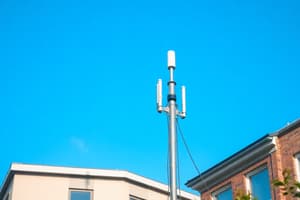Podcast
Questions and Answers
The microwave spectrum is usually defined as electromagnetic energy ranging from approximately ______ GHz to 1000 GHz in frequency.
The microwave spectrum is usually defined as electromagnetic energy ranging from approximately ______ GHz to 1000 GHz in frequency.
1
The L band frequency range is from ______ to 2 GHz.
The L band frequency range is from ______ to 2 GHz.
1
The C band frequency range is from ______ to 8 GHz.
The C band frequency range is from ______ to 8 GHz.
4
The Ka band frequency range is from ______ to 40 GHz.
The Ka band frequency range is from ______ to 40 GHz.
Waveguides can be generally classified as either ______ waveguides or dielectric waveguides.
Waveguides can be generally classified as either ______ waveguides or dielectric waveguides.
Waveguides are structures used to guide ______ waves from point to point.
Waveguides are structures used to guide ______ waves from point to point.
The fundamental characteristics of waveguide and transmission line waves are quite ______.
The fundamental characteristics of waveguide and transmission line waves are quite ______.
The differences in waveguide and transmission line waves result from the basic differences in ______ for a transmission line and a waveguide.
The differences in waveguide and transmission line waves result from the basic differences in ______ for a transmission line and a waveguide.
Metal waveguides normally take the form of an enclosed ______ conducting metal pipe.
Metal waveguides normally take the form of an enclosed ______ conducting metal pipe.
The dielectric waveguide consists of ______ only and employs reflections from dielectric interfaces to propagate the electromagnetic wave along the waveguide.
The dielectric waveguide consists of ______ only and employs reflections from dielectric interfaces to propagate the electromagnetic wave along the waveguide.
Flashcards are hidden until you start studying
Study Notes
Commercial Implementations
- Commercial implementations of wireless access technology operate in the 2.3 GHz, 2.5 GHz, 3.5 GHz, and 5.8 GHz ranges.
Wide Area Mobile Broadband Wireless Access
- MBWA protocols, such as IEEE 802.20 and ATIS/ANSI HC-SDMA (e.g., iBurst), operate between 1.6 GHz and 2.3 GHz to provide mobility and in-building penetration characteristics similar to mobile phones but with greater spectral efficiency.
Microwave Applications
- Microwave frequencies are used in:
- Cable TV and internet access on coaxial cable
- Broadcast television
- Mobile phone networks (e.g., GSM)
- Microwave radio broadcasting and telecommunication transmissions
- Television news transmission from remote locations
- Radar technology for detecting range, speed, and other characteristics of remote objects
- Radio astronomy
Microwave Sources
- Vacuum tube-based devices:
- Operate on the ballistic motion of electrons in a vacuum under the influence of controlling electric or magnetic fields
- Include magnetron, klystron, travelling wave tube (TWT), and gyrotron
- Solid-state sources:
- Field-effect transistor
- Tunnel diodes
- Gunn diodes
- Maser (Microwave Amplification by Stimulated Emission of Radiation): a device similar to a laser, operating at microwave frequencies
Communication
- Microwave point-to-point links were used for long-distance telephone calls before the advent of fiber optic transmission
- Frequency division multiplex was used to send up to 5,400 telephone channels on each microwave radio channel
- Wireless LAN protocols, such as Bluetooth and IEEE 802.11, use microwaves in the 2.4 GHz ISM band
- Licensed long-range Wireless Internet Access services use the 3.5–4.0 GHz range
- Metropolitan Area Networks: MAN protocols, such as WiMAX (Worldwide Interoperability for Microwave Access), operate between 2 to 11 GHz
Microwave Frequency Bands
- Microwave frequency bands, as defined by the Radio Society of Great Britain (RSGB), are:
- L band: 1 to 2 GHz
- S band: 2 to 4 GHz
- C band: 4 to 8 GHz
- X band: 8 to 12 GHz
- Ku band: 12 to 18 GHz
- K band: 18 to 26.5 GHz
- Ka band: 26.5 to 40 GHz
- Q band: 30 to 50 GHz
- U band: 40 to 60 GHz
- V band: 50 to 75 GHz
- E band: 60 to 90 GHz
Waveguides
- Waveguides are structures used to guide electromagnetic waves from point to point
- Types of waveguides:
- Metal waveguides: enclosed conducting metal pipes
- Dielectric waveguides: use dielectric interfaces to propagate the electromagnetic wave
Studying That Suits You
Use AI to generate personalized quizzes and flashcards to suit your learning preferences.




